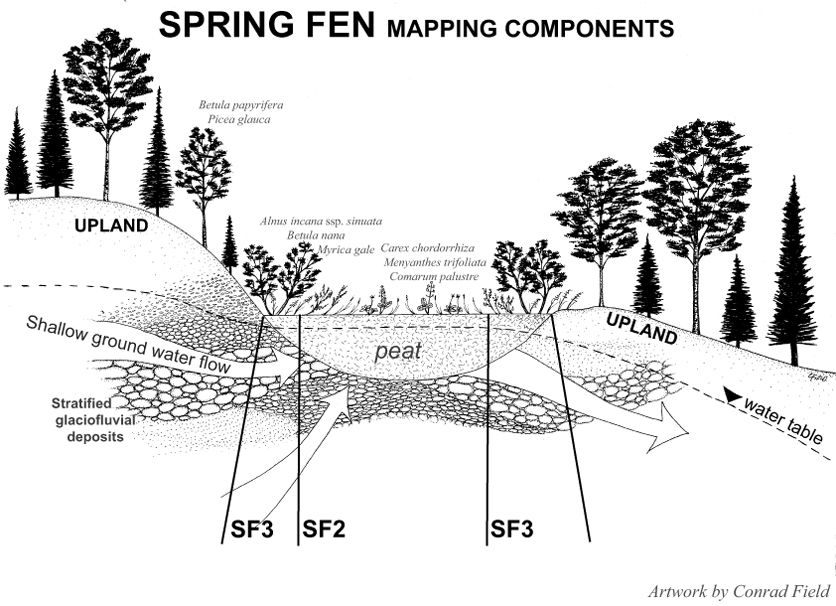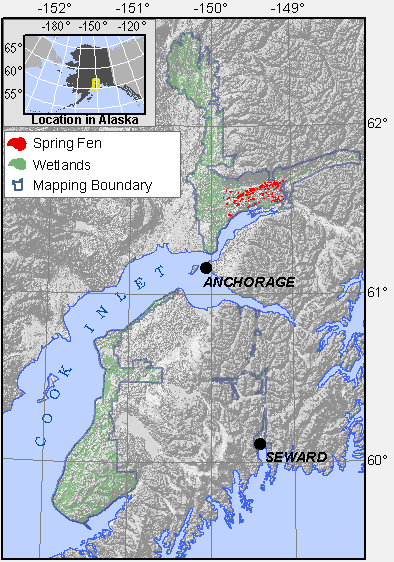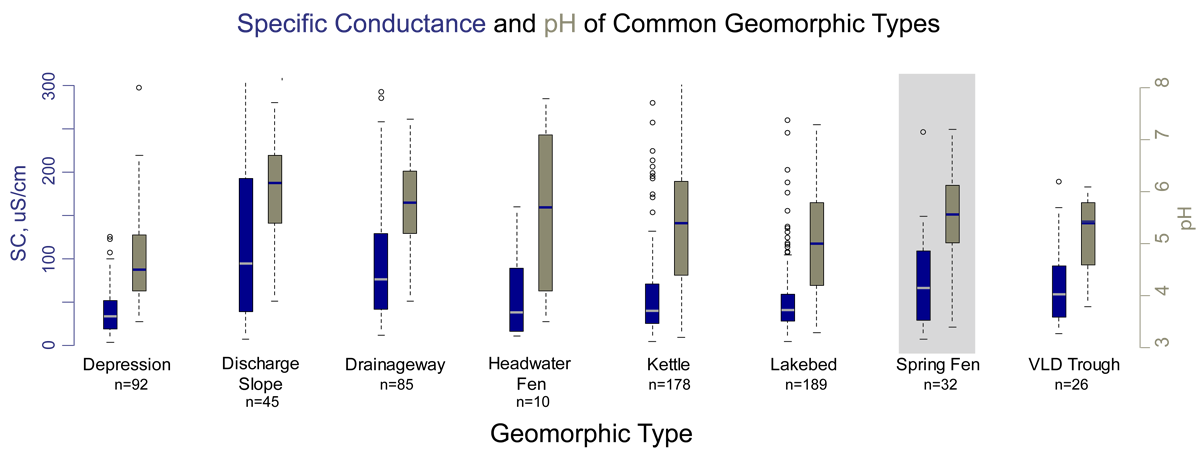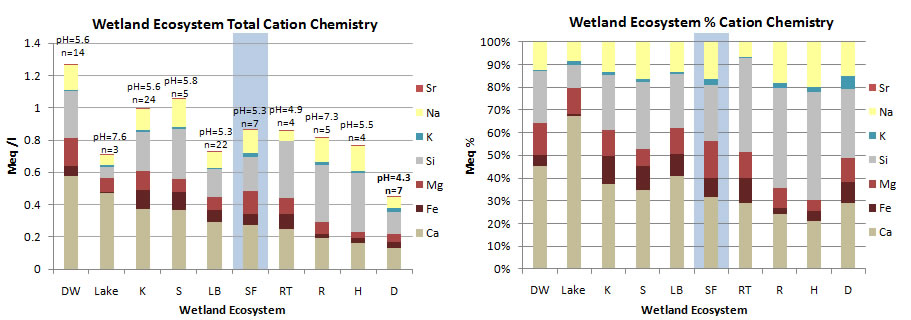
An idealized cross-section of a Spring Fen wetland showing the most common mapping components. Forested Spring Fens (SF4) and Spring Fen ponds (SF1) are less common. Drawing by Conrad Field.

Range map showing the distribution of Spring Fen wetlands.
Spring Fens are concentrated in the area between Wasilla & Palmer, where evapotranspiration exceeds precipitation, and wetlands are fed by ground water originating to the north, on Spring Fen wetlands are small peatlands surrounded by uplands. They are connected to other wetlands and to streams through shallow, unconfined groundwater movement through underlying permeable sediments. As such, they can be thought of as outcroppings of the local water table. They occur in the region of moisture deficit, between Butte and Houston below 1000 feet elevation, where evapotranspiration generally exceeds precipitation. Wetlands are not expected in such an area, and must be driven by groundwater discharge. The thick glacial sediments underlying the area of moisture deficit are well-sorted and coarse-grained in places, allowing ample groundwater discharge where surface topography intersects the relatively shallow water table (Jokela and Munter, 1991). Spring Fen wetlands occur in these topographic positions. Because of the steady supply of shallow groundwater, water table elevations in Spring Fens vary the least of any geomorphic wetland type in this classification.the slopes of Baldy Ridge.

A Spring Fen peatland north of Wasilla
Spring Fen wetlands are similar to Depression wetlands in that they are surrounded by uplands. However, Spring Fens have correspondingly higher pH and specific conductance, which indicates a strong connection to shallow groundwater. This is due to the coarser, more permeable sediments underlying Spring Fens.
Spring Fens occur on similar landforms as Kettles, but Kettles have a wetland or surface water connection to a navigable waterbody. Spring Fen, Kettle, and Depression Geomorphic Components all occur in ice-block depressions. Although they all occur in a similar geomorphic setting, they are distinguished by different underlying sediments and connection to other water bodies. These geomorphic differences influence important characteristics of both wetland jurisdiction and ecosystem services.
NWI and HGM
Spring Fens fall into the Palustrine category of the US Fish and Wildlife Service’s National Wetlands Inventory. Spring Fens support a variety of plant dominants from herbaceous emergents (PEM) to shrubs (PSS) and forest (PFO), with hydrologic regimes ranging from saturated through permanently, semi-permanently, and seasonally flooded (PSSB, PEMH, PEMF and PEMC, respectively). PEMF is probably the most common.
The LLWW Hydrogeomorphic classification of Tiner (2003) places Depression wetlands into its Terrene Basin isolated wetland category.

Box plots of Plant Prevalence Index (PI) in common wetland mapping components. Spring Fen wetlands (highlighted in gray) mapped with lower hydrologic component values (SF2 vs. SF4 for example) have lower values for Plant Prevalence Index. Prevalence Index is a good proxy for water table position and variability. Lower values indicate a water table closer to the surface for a longer portion of the growing season. An Index value equal to one indicates that the plot supported only wetland obligate plants (occur in wetlands greater than 99% of the time under natural conditions). A Prevalence Index value greater than 3 suggests that the plot may not be a wetland for jurisdictional purposes. Spring Fens generally have low PI values, indicating a groundwater supply that maintains the water table near the surface during most of the growing season. The maximum value of PI in Spring Fen components is always lower than the maximum value found in other geomorphic components with analogous hydrologic components. Compare especially SF4 with LB6, K4, DW5A, and D4, for example.
Prevalence Index is calculated from the percent cover and the wetland indicator status of each plant found in a wetland plot. Lower values indicate a higher prevalence of plants assigned a wetland indicator status of obligate or facultative. Indicator status is assigned nationally, by state, and by regions within states. Prevalence Index may be a better descriptor of the variability of the water table than one-time measurements of the actual position of the water table. Measurements are often made before the water table has fully equilibrated, and are dependent on antecedent conditions. However, if Indicator Status is accurately assigned the plants present will integrate long-term average conditions.
In the box plots, yellow boxes enclose the first through third quartile (where 50% of the data values lie); the gray bar is the median, and the whiskers extend to the last value within 1.5 times the inner quartile range. Values lying beyond 1.5 times the inner quartile range are plotted as hollow circles. The number of samples for each map component is given across the top.
Spring Fens (highlighted in blue) have the least fluctuating water tables of any Geomorphic Component. SF2 is the most common component, further indicating that Spring Fen water tables are frequently stable near the surface. These stable water tables are maintained by a strong groundwater discharge connection. Specific conductance values and pH are high compared to the other isolated Geomorphic Components: Depressions. D = Depression, K = Kettle; S = Discharge Slope; LB = Lakebed; SF = Spring Fen; RT = VLD Trough; R= Riparian; H = Headwater Fen; DW = Drainageway.

Box plots of specific conductance (blue) and pH (brown) in Spring Fens (gray). The median of pH is high compared to other peatland geomorphic settings, however a wide range values is also present. The high values suggest a strong groundwater influence, and the wide range likely represents the differences between bogs and fens. Specific conductance is also generally higher than in other peatland geomorphic settings (except for Drainageways), reflecting greater contributions from ground water.
In box plots, the boxes enclose the first through third quartile (where 50% of the data values lie); the horizontal bar in the box is the median value, and the whiskers extend to the last value within 1.5 times the inner quartile range. Values lying beyond 1.5 times the inner quartile range are plotted as hollow circles.
Wetland Indicators
| Table 1. Wetland Indicators in Spring Fen map components. | ||||||||
| Map Component | Peat Depth (cm) | Water Table (cm) | Redox features (cm) | Saturation (cm) | pH | Alkalinity mg/l as CaCO3 | Specific Conductance µS/cm | Plant Prevalence Index |
SF1 |
176 (4) | -28 (6) | 147 (2) | -26 (3) | 6.2 (14) | 0.0 (1) | 62 (14) | 1.05 (2) |
SF2 |
175 (14) | 2 (17) | 0.4 (17) | 5.1 (9) | 18.8 (4) | 81 (9) | 1.71 (15) | |
SF3 |
246 (6) | 11 (6) | 5.5 (6) | 4.8(5) | 0.0 (2) | 79.4 (5) | 2.13 (6) | |
SF4 |
180 (5) | 7 (6) | 2.3 (6) | 5.6(4) | 85.0 (4) | 1.96 (5) | ||
Explanation:
- Numbers in parentheses indicate number of samples.
- Peat depth is a minimum, because some sites had thicker peat deposits than the length of the auger used (between 160 – 493 cm).
- Water table depth is a one time measurement. At sites with seasonally variable water tables this measurement reflects both the conditions that year, and the time of year.
- Redox features with deep depths typically indicate deeper peat deposits, which mask redox indicators so the depth corresponds to the peat thickness.
- pH and specific conductance measured in surface water or a shallow pit with a YSI 63 meter calibrated each sample.
- Plant Prevalence Index calculated based on Alaska indicator status downloaded from the USDA PLANTS database, which may use different values than the 1988 list.
Soils and Plant Communities
| Table 2. Common soils and plant communities found in Spring Fens. | ||
| Map Component | COMMON SOILS | COMMON PLANT COMMUNITIES |
SF2 |
HISTOSOLS | Sphagnum spp. – Carex chordorrhiza |
SF3 |
HISTOSOLS | Sphagnum – Ericaceous shrub
Myrica gale – Betula nana / Equisetum fluviatile Sphagnum spp. – Carex rotundata Leatherleaf – Dwarf birch |
SF4 |
HISTOSOLS | Picea mariana / Ledum palustre ssp. decumbens
White spruce – Black spruce / Thinleaf alder |
| HISTOSOLS are any organic soils greater than 40 cm deep. | ||
Cation Chemistry

Spring Fen Hydrologic Components:
- SF1: Spring Fen Ponds.
- SF2: Spring Fens with water table near the surface. Often dominated by creeping sedge, marsh cinquefoil, and/or bluejoint reed grass.
- SF3: Spring Fens dominated by shrubs, especially thinleaf alder and dwarf birch.
- SF4: Spring fens with deeper fluctuating water table, forested.
| Table 3.Summary of Cook Inlet Spring Fen Map Unit occurrence. Spring Fens are only mapped in the Matanuska-Susitna Valley. | ||||
| Map Unit | N | Hectares | % Polygons | % Area |
| SF1 | 85 | 188 | 0.35 | 0.10 |
| SF12 | 10 | 12 | 0.04 | 0.01 |
| SF12d | 2 | 2.4 | 0.01 | 0.00 |
| SF1-3 | 6 | 16 | 0.02 | 0.01 |
| SF1-4 | 1 | 0.4 | 0.00 | 0.00 |
| SF1c | 7 | 19 | 0.03 | 0.01 |
| SF2 | 156 | 203 | 0.65 | 0.11 |
| SF21 | 17 | 35 | 0.07 | 0.02 |
| SF21d | 1 | 1.9 | 0.00 | 0.00 |
| SF23 | 37 | 115 | 0.15 | 0.06 |
| SF23d | 2 | 4.0 | 0.01 | 0.00 |
| SF2-4 | 13 | 56 | 0.05 | 0.03 |
| SF24d | 1 | 0.5 | 0.00 | 0.00 |
| SF2-4d | 1 | 1 | 0.00 | 0.00 |
| SF2c | 3 | 1.6 | 0.01 | 0.00 |
| SF2d | 3 | 1.9 | 0.01 | 0.00 |
| SF3 | 35 | 45 | 0.15 | 0.02 |
| SF31 | 1 | 1.2 | 0.00 | 0.00 |
| SF32 | 17 | 46 | 0.07 | 0.02 |
| SF34 | 20 | 60 | 0.08 | 0.03 |
| SF3d | 2 | 7.4 | 0.01 | 0.00 |
| SF4 | 22 | 159 | 0.09 | 0.08 |
| SF42 | 1 | 1.3 | 0.00 | 0.00 |
| SF43 | 17 | 92 | 0.25 | 0.46 |


